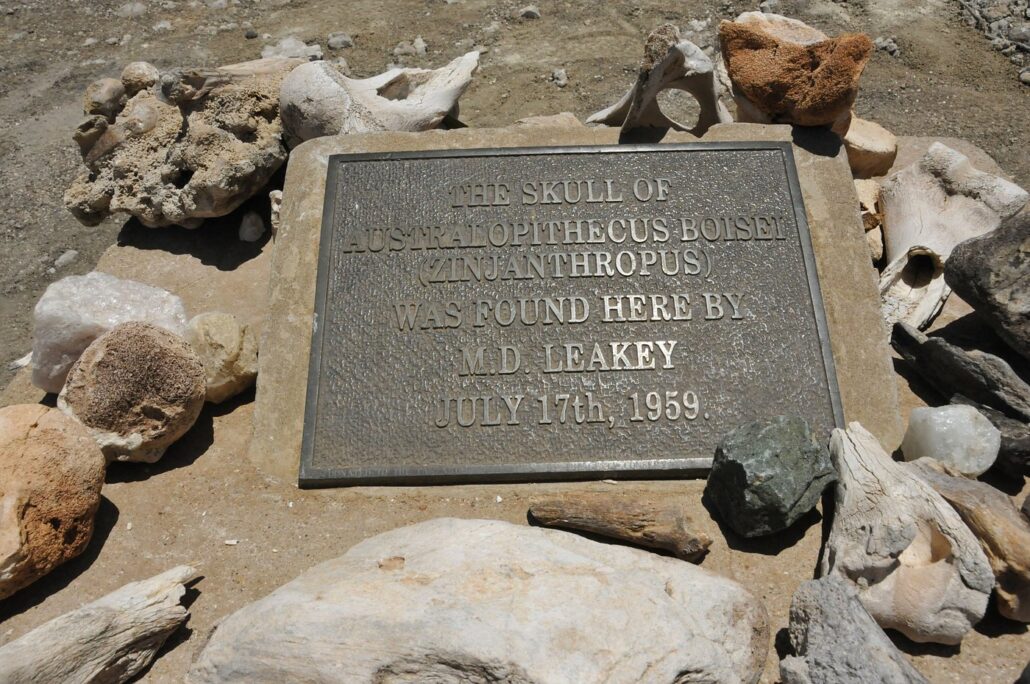Archaeological Sites In Ngorongoro
Archeological sites in Ngorongoro Conservation Area.The Olduvai Gorge, Nasera Rock in Ngorongoro crater and Laetoli are 3 major Archeological sites in Ngrongoro, which attracts most Archeologists who want to discover & find fossils & remains.
Olduvai Gorge – Archeological sites In Ngorongoro
Olduvai Gorge, often referred to as the “Cradle of Mankind,” is one of the most important archaeological sites in the world. Discovered by Louis and Mary Leakey in the 1950s, the gorge has yielded numerous fossils and stone tools that have significantly contributed to our understanding of early human evolution.
Highlights Of Olduvai Gorge
- Fossil Discoveries: The gorge has produced fossils of early hominids, including Homo habilis and Paranthropus boisei, dating back to around 1.9 million years ago.
- Stone Tools: Numerous Oldowan and Acheulean stone tools have been found, providing insight into the technological advancements of early humans.
- Geological Layers: The stratified layers of the gorge offer a chronological record of early human evolution and environmental changes.
Visitor Experience Of The Olduvia Gorge Acheolical site
- Olduvai Gorge Museum: The museum at Olduvai Gorge showcases a collection of fossils, tools, and informative displays about the history of the site and its significance. Interactive exhibits help visitors understand the context and importance of the discoveries.
- Guided Tours: Knowledgeable guides provide in-depth tours of the gorge, explaining the geological and archaeological significance of the site. Tours often include visits to the excavation areas where significant discoveries were made.
- Lecture Series: Occasionally, the site hosts lectures by visiting researchers and archaeologists, offering deeper insights into ongoing research and recent findings.
Laetoli – Archeological sites In Ngorongoro
Laetoli is another significant archaeological site located within the Ngorongoro Conservation Area. It is famous for its fossilized footprints, which provide direct evidence of bipedalism in early hominids.
Highlights of Laetoli Acheological site
- Footprint Trails: The site features a series of fossilized footprints made by early hominids over 3.6 million years ago. These footprints, preserved in volcanic ash, offer clear evidence of upright walking.
- Fossil Discoveries: Laetoli has also yielded fossils of Australopithecus afarensis, the same species as the famous “Lucy” skeleton found in Ethiopia.
Visitor Experience
- Footprint Viewing: While the original footprints are protected, casts and replicas are on display, allowing visitors to appreciate the significance of these ancient traces.
- Interpretive Tours: Guided tours provide detailed explanations of the footprints’ discovery, their significance, and what they reveal about early hominid locomotion and behavior.
- Interactive Exhibits: Exhibits at the site or associated museums often include interactive displays that allow visitors to compare the Laetoli footprints with those of modern humans and other primates.
Planning Your Archaeological Tour
How to Get There
- From Arusha: Olduvai Gorge is approximately a 4-5 hour drive from Arusha. The route takes you through scenic landscapes and can be combined with visits to other attractions in the Ngorongoro Conservation Area.
- From Serengeti: If you are visiting the Serengeti, Olduvai Gorge is accessible as a day trip. It is located on the way to the Ngorongoro Crater, making it a convenient stop.
Best Time to Visit Archeological sites In Ngorongoro
The Ngorongoro Conservation Area can be visited year-round. However, the dry season (June to October) is generally the best time for archaeological tours, as the weather is more predictable and roads are in better condition.
What to Bring
- Comfortable Clothing: Wear light, breathable clothing and sturdy walking shoes, as the tours often involve walking over uneven terrain.
- Sun Protection: Bring a hat, sunglasses, and sunscreen to protect yourself from the strong sun.
- Water and Snacks: Carry enough water to stay hydrated, especially during the hotter months, and bring some snacks for the longer tours.
- Camera: Don’t forget your camera to capture the stunning landscapes and significant archaeological sites.
Guided Tours and Packages
Many tour operators offer specialized archaeological tours of the Ngorongoro Conservation Area. These tours often include:
- Transportation: Transfers from major cities or lodges to the archaeological sites.
- Guided Tours: Professional guides who provide detailed information about the sites and their historical context.
- Accommodation: Packages may include stays at nearby lodges or campsites.
- Combined Itineraries: Many tours combine archaeological sites with wildlife safaris, providing a comprehensive experience of the NCA.
Tips for a Great Experience
- Book in Advance: Archaeological tours can be popular, especially during peak seasons, so it’s advisable to book in advance.
- Hire Knowledgeable Guides: A good guide can significantly enhance your understanding and appreciation of the sites.
Be Respectful: Remember that these sites are of great historical and scientific importance. Follow all guidelines and respect the environment and any instructions provided by your gu
